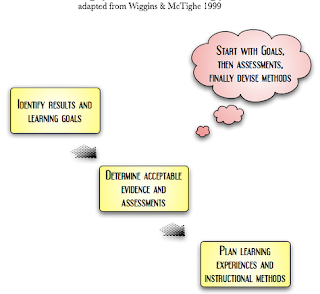1. Backward design starts with the desired results. What is it that we want
What is Backward Design?
our audience to learn? What concepts need to be developed? Are they
based on content standards? Life Skills? Determine these first.
Given that there are usually more concepts available than can be
addressed in a curriculum, one must prioritize desired results. Determine:
a) What’s worth being familiar with; b) What’s important to know or do; and
c) What should be considered “enduring” understandings, things that are
important for the audience to retain after they’ve forgotten many of the
details?
How do I determine what’s most important to include? Suggested filters:
a. Determine the “big ideas” that are essential for understanding. Do
not “clutter” a curriculum with facts and ideas that are not going to
having enduring value.
b. What will allow for authentic learning experiences that involve
learners the opportunity to “do” the subject rather than be told or
demonstrated the subject?
c. Concepts, processes, and/or skills that learners often have difficulty
understanding or mastering are important ones to consider. Teach
for understanding such that the learners can gain an understanding
or master a skill.
d. Decide what ideas, topics, or processes are most interesting to
your audience and will most likely engage the learners. (Is what
you choose interesting to your specific audience, or to you?)
2. How will we know if our audience has learned the content, Life Skill, or
skill that is our desired result? Determine the acceptable evidence (based
on the desired results) that will help the educator determine whether or not
acceptable levels of learning have taken place.
How do I assess whether or not learning has occurred? Understanding
does not appear magically at the end of an activity, program, or project;
rather, it develops over time as a result of ongoing exploration, reflection,
and further questioning by the learner. With that in mind, assessment
should not be an isolated event (e.g., test or survey) at the end of a
program, project, or activity. The assessment of understanding should be
a collection of evidence that is gathered over time. In 4-H, an
“Assessment Continuum” might look like the following:
Informal Checks for Understanding
observations, informal dialogues) used to provide evidence of
learning during the Exploration Phase of the Learning Cycle.
(e.g., questions,
Academic Prompts
learners to think critically about the concept being explored; not a
recitation of facts) can help assess learners as a component of the
Exploration and Concept Development Phases of the Learning
Cycle.
(open-ended questions that challenge the
Performance Tasks and/or Projects
require the transfer of knowledge and skills to an independent
situation) can provide evidence as part of the Concept Application
Phase of the Learning Cycle.
3. Plan the learning experiences and instruction.
With clearly identified results and assessment tools identified, “Curriculum
Architects” can now proceed to planning their instructional activities. Key
questions to consider include:
(e.g., authentic tasks that
What background knowledge, skills, and/or abilities will the learners
What is the best instructional method? Will advance teaching or
What materials and resources will be needed? How can these be
Does the design of the activities flow well and is it effective in
Why is “backward” a desirable approach?
Many educators design activities and teach they way they were taught. They
often design activities using what they know from previous experience, which
usually includes traditional approaches (e.g., lectures or demonstrations) to wellestablished
activities, rather than beginning at the “design codes” that need to
drive our work. Furthermore, results from activities, projects, and programs are
typically assessed only once: A “snapshot of knowledge” test at the end of the
activity, project, or program. The Backward Design looks at what the learners
need first and targets assessment and instructional strategies around those
needs.
ที่มา: http://www.nitesonline.net/download/Backward.pdf
What is the Backward Design Method?



